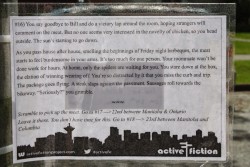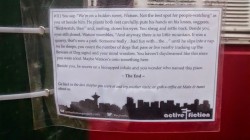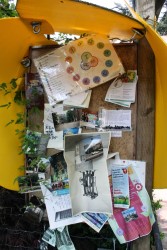Take off the Oculus and power down: all you need to play Gone Home is a house. Go figure! The graphics leap past the uncanny valley; the sound design is remarkable in its verisimilitude, with a whole radio full of stations and live DJs. The only problem is that there are so many distracting details (look, the toilets all flush!) that it’s easy to stray from the path of the main quest and get sidetracked in emergent side-stories.
The Active Fiction Project — what are the odds that in this world, “active fiction” would evolve parallel to interactive fiction? — has made it easy for you. In place of a map and modeled rooms, they present you a gameplay environment of — the world. That is, a subset of the world, consisting of one neighbourhood, Riley Park, in the city of Vancouver, Canada. And in this neighbourhood, story nodes with branching choices sporadically appear on laminated printouts attached to street signs and lamp posts with zap straps, the most low-tech version of augmented reality imaginable. Each placard contains a story segment and presents a few choices at the end, which can be invoked by visiting specifically described physical locations (eg. “the SE corner (aha, the artificial imposition of compass directions persists!) of Quebec St. and 26th Avenue”) where the next cards, and their story sections, are to be found. In a neat bit of contextual dovetailing, the setting of the story events coincides with the location of the cards, so cards found in parks will describe outdoor activities there, cards in commercial areas will concern themselves with visits to local businesses, etc: the map IS the territory!
The project is the brainchild of regional planner Jaspal Marwah, who moonlights as the public art coordinator of the Vancouver Public Space Network. An example of their previous public art projects might include the surprise appearance of several brighly-decorated upright pianos installed at neighbourhood street corners for pedestrians to use to channel their inner Jerry Lee Lewis, but as Jaspal has noted, public art is rarely literary in nature: for all the murals or mosaics installed or cacophonous live-music street parties (or public transit flashmobs) blared, insertion of simple words into public spaces falls way behind. They’re not entirely unknown, but will typically take the form of short and ambiguous poetic phrases expensively cut into sheet metal or programmed into LED displays — not much to sink your teeth into. (Author Douglas Coupland had a residency at a local hotel’s marquee a few years back, but let’s face it, he’s no Jenny Holzer.) And interaction with literary public art? Why, it’s nigh unheard-of!
Jaspal brought the matter to University of British Columbia Creative Writing inst ructor Timothy Taylor, who posed the challenge to his students. The first to rise to meet it, Nicole Boyce, presented the inaugural Active Fiction story in May of 2014, in conjunction with a series of walking tours celebrating the ideas of urban planner Jane Jacobs. It was entitled The Raffle, and concerns itself with an attempt by a new arrival to town to make some friends in the area. (SPOILER ALERT: A meat draw in the Legion Hall figures prominently, lending the piece its name.)
ructor Timothy Taylor, who posed the challenge to his students. The first to rise to meet it, Nicole Boyce, presented the inaugural Active Fiction story in May of 2014, in conjunction with a series of walking tours celebrating the ideas of urban planner Jane Jacobs. It was entitled The Raffle, and concerns itself with an attempt by a new arrival to town to make some friends in the area. (SPOILER ALERT: A meat draw in the Legion Hall figures prominently, lending the piece its name.)
Legion love? This local spot is a part of the #activefic story (of course). Go check it out while you still can! pic.twitter.com/m6pn9QF7qI
— active fiction (@activefic) May 10, 2014
The cards were up for nearly three weeks, and then they came down again. Suddenly, the game unplayable, the story unreadable — all we were left with was the Monopoly board without any of the dice, cards, money or tokens! Our mission, we chose to accept… this message had now self-destructed. Thanks for the memories! (This author documented the cards for posterity,
but reading them removed from their geographical context is as incomplete an experience as an Infocom marathon with no feelies! Not a great candidate for the Situationist game of navigating one area using the map of another; this would be more akin to watching your favorite movie, remade with new actors — they’d speak the same lines, but it just wouldn’t quite be right.)
The second and most recent work of Active Fiction went up in November of 2015, again for a limited lifespan of a few weeks. “In Search of Little Mountain”, by playwright Sarah Higgins, was nominally concerned with a search for the origin of the neighbourhood’s name; like the previous story, it also presented low-stakes slice-of-life vignettes somewhere between a
Seinfeld episode and a Samuel Beckett play, where zany characters interact with vaguely-defined (AFGNCAAP) readers in broad strokes with many, many paces between opportunities for story paragraph injection and game-choice availability.

In a sense these little scattered scripts are plays that are 99% intermission, doubling down as scene changes. Similarities come to mind with the “Zombies, Run!” fitness app for smartphones, which makes you travel distances (but nowhere in
particular) at speed to successfully (avoid being eaten by zombies and) further major plot points in a post-apocalyptic audiodrama. Active Fictions, by contrast, make you move to very specific places at any pace you like to advance vague events and happenings in the mundane everyday here and now. (Also, to be clear, none of them contain any zombies — thus far.)
The Active Fiction Project turns out all the lights between those handful of weeks when their stories are up on the streets, so it’s difficult to know exactly when to expect them to spin back into motion. That said, with the limited sample size of two releases to date to work with, one might reasonably conjecture that we’ll see another installment out this month — for the
series’ first anniversary! Perhaps fans of (inter)active fiction who find themselves pounding the pavements of Canada’s most expensive and least satisfied city might find at least one free and public thing to look forward to.
Additional links:
http://www.cbc.ca/player/Radio/Local+Shows/British+Columbia/On+The+Coast/ID/2454783513/
http://thethunderbird.ca/2014/12/09/storytelling-leaps-from-the-page-to-vancouver-park/

